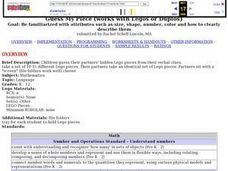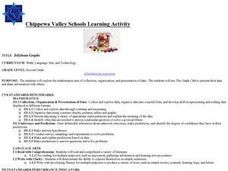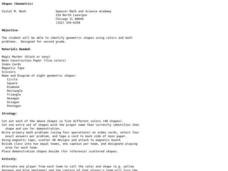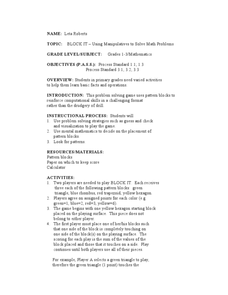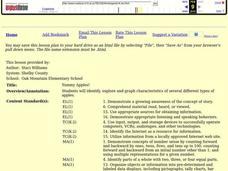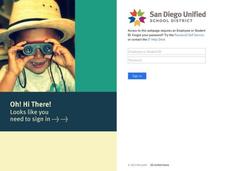Curated OER
Guess My Piece -working with Legos
Students participate in guessing their partners' hidden Lego pieces from their verbal clues. They work in partners to accomplish their goals. They are meeting a variety of math standards by completing this lesson.
Curated OER
Fact Family
In this math worksheet, students list the number sentences in the house and then organize the math facts while comprehending the rules of commutativity.
Curated OER
M & M Madness
Second graders graph M & M's by color. In this graphing lesson plan, 2nd graders first predict how many of each color they think are in a handful of M & M's. Then they graph the amounts of each color on a computer program....
Curated OER
Jellybean Graphs
Second graders predict and graph data based on the color of jelly beans they think are in a handful. In this prediction lesson plan, 2nd graders will predict how many of each color jellybean are in a handful. Then they graph these...
Curated OER
Mixed Review
In this math worksheet, students solve the problems using the operation of addition to fill in the missing addends. They also apply some basic knowledge of geometry to solve the second set of questions.
Curated OER
Shapes (Geometric)
Second graders explore various geometric shapes. For this math lesson plan, 2nd graders identify geometric shapes using colors and math problems.
Curated OER
Three Little Kittens: Addition Booklet
Students explore math problem solving strategies while reading a nursery rhyme. In this addition lesson, students learn math skills such as solving simple equations, graphing data and extending patterns while reading The Three Little...
Curated OER
Addition up to 5
In these addition worksheets, students complete several addition problems using the blocks in the first 8 problems. Students then complete 8 more sets of addition problems that use visual aids and tables for help.
Curated OER
Fact Families
In this fact families worksheet, learners fill in 6 pictures of a house with a fact family. Groups include 3, 5, 8 and 4, 7,11.
Curated OER
Block It: Using a Manipulative to Solve Math Problems
Students practice using visuals to solve math problems. In this math manipulative lesson, students utilize pattern blocks to participate in a class game in which geometric shapes touch other player's pieces. Students gain points based on...
Curated OER
Patterns
Second graders create an ABAB pattern with their name. In this early elementary math lesson, 2nd graders first model their names in an ABAB pattern with unifix cubes. They then recreate the pattern using letter stamps on KidPix.
Curated OER
Funtastic Fractions
Students discover fractions by creating models. In this fractions lesson, students read Give Me Half! by Stuart J. Murphy and view a video about what fractions actually represent. Students divide a square piece of paper a certain amount...
Curated OER
Dinoset 2: Counting By 2's And 5's
Second graders practice counting by 2's and 5's. They complete five math problems counting by 2's and five math problems counting by 5's. They play a game by typing in a number that belongs in an egg and play By Five's to a 100.
Curated OER
Graph Club 2.0 Matching
Second graders study graphing using pictographs and bar graphs. They graph pie charts, line graphs, and also change the graph scale up to 1000. They use the pictograph on the left to create the same graph on the right using a bar graph.
Curated OER
Yummy Apples!
Learners discuss apples and how they are grown. They listen as the teacher reads "Apples," by Gail Gibbons. Students discuss the story. They view several different types of apples and compare their characteristics. Learners taste several...
Curated OER
Apple Addition
For this addition worksheet, students add simple one-digit numbers. They write their sum in the apple below the equation. Addition facts zero through eight are represented. Sums to extend to eighteen. Twenty-five problems are on each...
Curated OER
Apple Addition - To Sums of 10
In this addition worksheet, students add columns of one-digit numerals. They write their answer in the apple provided below the addition equation. There are 25 problems on a page and four pages are provided. Sums are not greater than 10....
Curated OER
Perimeter Playground
Young scholars explore geometry by participating in a school measuring activity. In this perimeter lesson, students discuss the techniques and methods used in order to measure a large perimeter or geometric figure. Young scholars utilize...
Curated OER
Grade 2: Spinning Sums
Second graders collect data by spinning two spinners and creating sums, organize the data, and make conclusions from the data. Each students makes a spinner. They spin and record the number of the section each time. Students work in...
Curated OER
Rocks
Young scholars use their five senses to experience different types of rocks. In groups, they compare and contrast the information they collected. They observe rocks in their local community and describe their uses to the class.
Curated OER
Use Symbols to Subtract
Students practice crossing out items in a group in order to complete subtraction problems. In this subtraction lesson plan, students watch a PowerPoint presentation and then practice problems on their own.
Curated OER
Block It Game
Students use problem solving strategies such as guess and check and visualization to play the game. They use mental mathematics to decide on the placement of pattern blocks and look for patterns.


